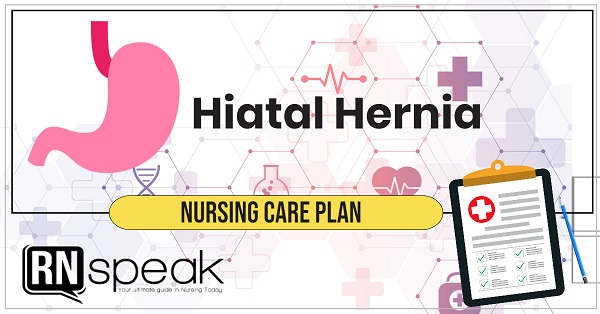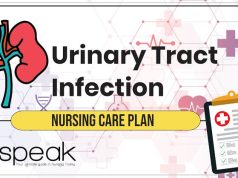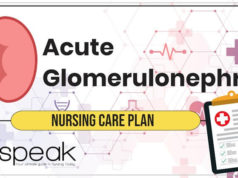Hiatal hernias are more common in Western countries. Most hiatal hernias are asymptomatic and are discovered incidentally. On rare occasions, a life-threatening complication, such as gastric volvulus or strangulation, may present acutely .
A hiatal hernia occurs when a portion of the stomach prolapses through the diaphragmatic esophageal hiatus. The stomach pushes through an opening in the diaphragm and into the chest and compromises the lower esophageal sphincter (LES). This laxity of the LES can allow gastric content and acid to back up into the esophagus and is the leading cause of gastroesophageal reflux (GERD) .
The classification of hiatal hernias is divided into four types.
- Type I (sliding type). This represents more than 95% of hiatal hernias, which occur when the gastroesophageal junction (GEJ) is displaced upwards towards the hiatus.
- Type II. This type is a paraesophageal hiatal hernia, which occurs when part of the stomach migrates into the mediastinum parallel to the esophagus.
- Type III. this is both a paraesophageal hernia and a sliding hernia, where both the GEJ and a portion of the stomach have migrated into the mediastinum.
- Type IV. Type IV is when the stomach, as well as an additional organ such as the colon, small intestine, or spleen, also herniates into the chest.
Hiatal hernias may be congenital or acquired. Predisposing factors include the following:
- Advanced age. Muscle weakening and loss of elasticity as people age is thought to predispose to hiatal hernia, based on the increasing prevalence in older people. With decreasing tissue elasticity, gastric cardia may not return to its normal position below the diaphragmatic hiatus following a normal swallow.
- Gender. Hiatal hernias are more common in women. This may relate to the intra-abdominal forces exerted in pregnancy.
- Diet. A study suggested that the Western, fiber-depleted diet leads to a state of chronic constipation and straining during bowel movement, which might explain the higher incidence of this condition in Western countries.
- Comorbidities. Conditions such as chronic esophagitis may cause shortening of the esophagus by causing fibrosis of the longitudinal muscles and, therefore, predispose to a hiatal hernia. The presence of abdominal ascites also is associated with hiatal hernias.
Hiatal Hernia
The gastroesophageal junction acts as a barrier to prevent the reflux of contents from the stomach into the esophagus by a combination of mechanisms forming the anti-reflux barrier. The components of this barrier include the diaphragmatic crura, the LES baseline pressure and intra-abdominal segment, and the angle of His. the presence of a hiatal hernia compromises this reflux barrier not only in terms of reduced LES pressure but also reduced esophageal acid clearance. Clients diagnosed with hiatal hernias also have longer transient LES relaxation episodes, particularly at night time. These factors increase the esophageal mucosa acid contact time predisposing to esophagitis and related complications.
The typical presentation leading to an evaluation for a hiatal hernia is GERD. Clients typically complain of heartburn and sometimes regurgitation. While heartburn is the most common complaint, some clients will present with extra-esophageal symptoms such as a chronic cough or asthma. The presentation of regurgitation or extra-esophageal symptoms typically is a sign of disease progression.
Management for hiatal hernias depends on the type of hernia and the severity of the symptoms. The goals of treatment include prevention of reflux of gastric contents, improved esophageal clearance, and reduction in acid production. The following are nursing diagnoses associated with hiatal hernia.
- Acute Pain
- Risk for Bleeding
- Imbalanced Nutrition: Less than Body Requirements
Hiatal Hernia Nursing Care Plan
Below are sample nursing care plans for the problems identified above.
Acute Pain
Hiatal hernia results from the translocation of intra-abdominal contents from their usual position into the thorax. The symptomatology can range from just chest pain in the less severe types to respiratory and hemodynamic compromise resulting from strangulation in the advanced hernias. The acid may also cause ulcerations within the stomach that can bleed and lead to acute anemia and pain.
Nursing Diagnosis
- Acute Pain
Related Factors
- Chemical burn of gastric mucosa or oral cavity
- Physical response, such as reflex muscle spasm in the stomach wall
Evidenced by
- Verbalizations of pain
- Abdominal guarding
- Rigid body posture
- Facial grimacing
- Autonomic responses, such as changes in vitals signs in reaction to acute pain
Desired Outcomes
- The client will verbalize relief of pain.
- The client will demonstrate a relaxed body posture and be able to sleep or rest appropriately.
Nursing Interventions
| Assessment | Rationale |
| Assess reports of pain, including location, duration, and intensity. | Pain is not always present, but if present, should be compared with the client’s previous pain symptoms. This comparison may assist in the etiology and development of complications. |
| Note nonverbal pain cues such as restlessness, reluctance to move, abdominal guarding, tachycardia, and diaphoresis. | Nonverbal cues may be both physiological and psychological and may be used in conjunction with verbal cues to evaluate the extent and severity of the problem. |
| Identify factors that aggravate or alleviate the pain. | This may be helpful in establishing diagnosis and treatment needs. |
| Independent | |
| Provide small, frequent meals, as indicated for the individual client. | Food has an acid-neutralizing effect ad dilutes the gastric contents. Small meals prevent distention and the release of gastrin. |
| Identify and limit foods that create discomfort. | Specific foods that cause distress vary among individuals. Spicy foods, alcohol, and coffee can precipitate dyspepsia. The 2005 guidelines from the American College of Gastroenterology (ACG) also suggest avoiding peppermint and possibly the onion family . |
| Assist the client with active and passive range-of-motion exercises. | This reduces joint stiffness, minimizing pain and discomfort. |
| Elevate the head of the bed after meals and avoid eating 3 hours before bedtime. | Wait 3 hours after a meal before lying down and elevate the head of the bed by 8 inches to avoid regurgitation of ingested food. |
| Provide frequent oral care and comfort measures including back rubs and position changes. | Halitosis from stagnant oral secretions is unappetizing and can aggravate nausea. Gingivitis and dental problems may arise. |
| Dependent/Collaborative | |
| Provide and implement prescribed dietary modifications. | The client may receive nothing by mouth initially. When oral intake is allowed, food choices depend on the diagnosis and etiology of the ulceration. |
| Use regular rather than skim milk, if milk is allowed. | Fat in regular milk may decrease gastric secretions; however, the calcium and protein content (especially in skim milk) increases secretions. |
| Administer analgesics as prescribed. | Analgesics relieve acute or severe pain. Morphine also reduces peristaltic activity, and ketorolac exerts anti-inflammatory effects. |
| Administer antacids as indicated. | Antacids decrease gastric acidity by absorption or by chemical neutralization. Evaluate the choice of antacid in regard to the total health picture, such as sodium restriction. |
| Administer proton pump inhibitors (PPIs) as prescribed. | PPIs are the most powerful medications available for treating GERD. these agents should be used only when this condition has been objectively documented. They have a few adverse effects. Available PPIs include omeprazole, lansoprazole, rabeprazole, and esomeprazole. |
| Assist in surgical management as indicated. | Surgery is only necessary in the minority o clients with complications of GERD despite aggressive treatment with PPIs. three types of surgical procedures correct GERD and repair the hernia in the process. They can be performed by open laparotomy or with laparoscopic approaches. This includes the Nissen fundoplication, Belsey fundoplication, hill repair, and magnetic sphincter augmentation (MSA). |
Risk for Bleeding
A hiatal hernia may be responsible for intermittent bleeding from associated esophagitis, and erosions (Cameron ulcers), or a discrete esophageal ulcer, leading to iron-deficiency anemia. Splenic and live injuries may also result in bleeding and occurs in 2.3% of clients.
Nursing Diagnosis
- Risk for Bleeding
Risk Factors
- Active fluid volume loss
- Ulcerations
Evidenced by
- Not applicable; the presence of signs and symptoms establishes an actual diagnosis
Desired Outcomes
- The client will be free of signs of bleeding in GI aspirate or stools, with stabilization of hemoglobin and hematocrit.
- The client will demonstrate improved fluid balance as evidenced by individually adequate urinary output with normal specific gravity, stable vital signs, moist mucous membranes, good skin turgor, and prompt capillary refill.
Nursing Interventions
| Assessment | Rationale |
| Note the color and characteristics of vomitus, nasogastric tube drainage, and stools. | The first step in managing bleeding is to determine its location. The bright red blood that does not clear signals recent or acute arterial bleeding, perhaps caused by gastric ulceration’ dark red blood may be old blood that has been retained in the intestines or venous bleeding from varices. Coffee-ground appearance is suggestive of partially digested blood from a slowly oozing area. |
| Assess vital signs. | Changes in BP and pulse may be used for a rough estimate of blood loss; BP less than 90 mm Hg and pulse greater than 110 suggest a 25% decrease in volume or approximately 1,000 ml. Postural hypotension reflects a decrease in circulating volume. |
| Note the client’s individual physiological response to bleeding, such as changes in mentation, weakness, restlessness, anxiety, pallor, diaphoresis, tachypnea, and temperature elevation. | Symptomatology is useful in gauging the severity and length of bleeding episodes. Worsening symptoms may reflect continued bleeding, inadequate fluid replacement, and shock. |
| Measure central venous pressure (CVP) if indicated. | CVP reflects circulating volume and cardiac response to bleeding and fluid replacement. CVP values between 5 and 29 cm H20 usually reflect adequate fluid volume. |
| Monitor intake and output and correlate with weight changes. | Measure blood and fluid losses via emesis, gastric suction or lavage, and stools. This provides guidelines for fluid replacement. |
| Independent | |
| Keep an accurate record of subtotals of solutions and blood products during replacement therapy. | A potential exists for over-transfusion of fluids, especially when volume expanders are given before blood transfusions. |
| Maintain bedrest; prevent vomiting and straining at stool. | Schedule the client’s activities to provide undisturbed rest periods. Activity and vomiting increase intra-abdominal pressure and can predispose to further bleeding. |
| Elevate the head of the bed. | This prevents gastric reflux and aspiration of antacids, which can cause serious pulmonary complications. |
| Note signs of renewed bleeding after cessation of the initial bleeding. | Increased abdominal fullness and distention, nausea or renewed vomiting, and bloody diarrhea may indicate the return of bleeding. |
| Provide clear or bland fluids when intake is resumed. Avoid caffeinated and carbonated beverages. | Fluids are easily digested and reduce the risk of added irritation to inflamed tissues. Caffeine and carbonated beverages stimulate hydrochloric acid production, possibly potentiating bleeding. |
| Dependent/Collaborative | |
| Prepare for urgent endoscopy. | Endoscopy is indicated within 24 hours of diagnosis of UGIB and intervention when the client presents with hematemesis, melena, or postural changes in blood pressure. |
| Monitory laboratory values. | This aids in establishing blood replacement needs and monitoring the effectiveness of therapy. |
| Administer intravenous fluids or volume expanders, as indicated. | Fluid replacement with isotonic crystalloid solutions depends on the degree of hypovolemia and duration of bleeding. The majority of gastric bleeding can be managed without transfusion of blood products. |
| Insert and maintain large-bore NGT in acute bleeding. | This provides an avenue for removing irritating gastric secretions, blood, and clots. It also reduces nausea and vomiting and facilitates diagnostic endoscopy. |
| Administer PPIs as prescribed. | PPIs have been shown in studies to be most effective after GI bleeding to reduce the recurrence of bleeding. PPIs can supress acid secretion and have a long duration of action. |
| Assist in surgical interventions as indicated. | Total or partial gastrectomy, pyloroplasty, and vagotomy may be required to control and prevent future gastric bleeding. Shunt procedures may be performed to divert blood flow and reduce pressure within the esophageal vessels when other measures fail. |
Fear/Anxiety
Nursing Diagnosis
- Fear/Anxiety
Related Factors
- Change in health status
Evidenced by
- Increased tension, restlessness, irritability
- Tachycardia
- Diaphoresis
- Lack of eye contact, focus on self
- Verbalizations of anxiety
- Panic
Desired Outcomes
- The client will discuss fears and concerns recognizing healthy versus unhealthy fears.
- The client will verbalize an appropriate range of feelings.
- The client will appear relaxed and report anxiety is reduced to a manageable level.
- The client will demonstrate problem-solving and effective use of resources.
Nursing Interventions
| Assessment | Rationale |
| Monitor physiological responses, such as tachycardia, palpitations, dizziness, headache, tingling sensations, restlessness, and irritability. | These symptoms may indicate the degree of fear the client is experiencing. The client may feel out of control of the situation or reach a state of panic. |
| Assess the level of anxiety. | Overwhelming anxiety or persistent fears may result in excessive stress reactions. This may further aggravate pain and other symptoms such as tachycardia and shortness of breath. |
| Independent | |
| Encourage verbalization of concerns. Assist the client in expressing feelings by active listening. | This establishes a therapeutic relationship and assists the client in dealing with feelings. This also provides an opportunity to clarify misconceptions. |
| Acknowledge that this is a fearful situation and that others have expressed similar fears. | When the client is expressing their own fear, the validation that these feelings are normal can help the client feel less isolated. |
| Provide accurate, concrete information about what is being done, including sensations to expect and usual procedures undertaken. | This involves the client in the plan of care and decreases unnecessary anxiety about unknowns. |
| Provide a calm, restful environment. | Removing the client from outside stressors promotes relaxation and may enhance coping skills. |
| Encourage the caregiver to stay with the client as much as possible. | This helps reduce the fear of going through a frightening experience alone. Use touch and eye contact as appropriate when communicating with the client and respond to call signals promptly if possible. |
| Provide an opportunity for the caregiver to express feelings and concerns. | Encourage the caregiver to project a positive, realistic attitude. This helps them deal with their own anxiety and fears that can be transmitted to the client. This also promotes a supportive attitude that can facilitate recovery. |
| Demonstrate and encourage relaxation techniques such as visualization, deep-breathing exercises, and guided imagery. | Learning ways to relax can be helpful in reducing fear and anxiety. Because the client may be a person who has difficulty relaxing, learning these skills can be important to recovery and prevention of recurrence. |
| Assist the client in identifying positive coping behaviors used successfully in the past. | Successful behaviors can be fostered in dealing with current fear, enhancing the client’s sense of self-control, and providing reassurance. |
| Dependent/Collaborative | |
| Administer medications as indicated. | Sedatives and antianxiety agents may be used on occasion to reduce anxiety and promote rest, particularly in a client with an ulcer. |
| Refer the client to a psychiatric clinical nurse specialist, social services, or spiritual advisor. | The client may need additional assistance during recovery to deal with the consequences of an emergency situation and adjustments to the required and desired changes in lifestyle. |
References
- Doenges, M. E., Moorhouse, M. F., & Murr, A. C. (2010). Nursing Care Plans: Guidelines for Individualizing Client Care Across the Life Span. F.A. Davis Company.
- Khan, M. Z. (2020, November 12). Chest Pain: A Relatively Benign Symptom of Type IV Hiatal Hernia. NCBI. Retrieved January 14, 2023, from https://www.ncbi.nlm.nih.gov/pmc/articles/PMC7733775/
- Patti, M. G., & Anand, B. (2021, October 20). Gastroesophageal Reflux Disease: Practice Essentials, Background, Anatomy. Medscape Reference. Retrieved January 14, 2023, from https://emedicine.medscape.com/article/176595-overview#a1
- Qureshi, W. A., & Katz, P. O. (2019, September 5). Hiatal Hernia: Practice Essentials, Background, Pathophysiology. Medscape Reference. Retrieved January 14, 2023, from https://emedicine.medscape.com/article/178393-overview#a5
- Smith, R. E., & Shahjehan, R. D. (2022, August 22). Hiatal Hernia – StatPearls. NCBI. Retrieved January 14, 2023, from https://www.ncbi.nlm.nih.gov/books/NBK562200/








